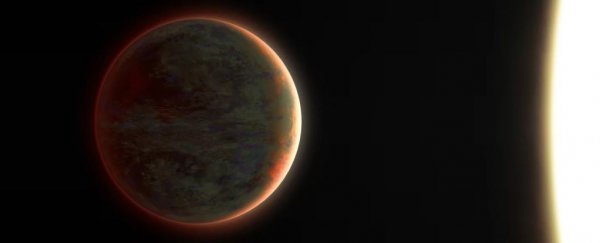A giant exoplanet 855 light-years away is so extreme, it has clouds of vaporized metals and rains liquid rubies and sapphires.
That's the conclusion astronomers have reached after probing its atmosphere – the most detailed such analysis to date, revealing for the first time the conditions and dynamics of the exoplanet's permanent night side.
"Despite the discovery of thousands of exoplanets, we've only been able to study the atmospheres of a small fraction due to the challenging nature of the observations," says astronomer Thomas Mikal-Evans of the Max Planck Institute for Astronomy in Germany.
"We're now moving beyond taking isolated snapshots of specific regions of exoplanet atmospheres, to study them as the 3D systems they truly are," he adds.
The exoplanet in question is one of the most famous and well-studied we've seen to date. It's called WASP-121 b, first discovered in 2015, a gas giant about 1.18 times the mass and 1.81 times the size of Jupiter, on a close orbit of its star of just 1.27 days. Two years after it was discovered, WASP-121 b became the first exoplanet in whose stratosphere water had been found.
It is, however, extremely unlikely that WASP-121 b could be habitable. On such a close orbit, it's exceedingly hot, with temperatures that range between 1,500 and 3,000 Kelvin (1,227 to 2,727 degrees Celsius, or 2,240 to 4,940 degrees Fahrenheit).

The size and proximity of WASP-121 b to its host star, WASP-121, place it firmly in the category of hot Jupiters, gas giant exoplanets on orbits of less than 10 days with their host stars. Of the almost 5,000 exoplanets confirmed to date, over 300 belong to this extreme category, but WASP-121 b has been referred to as a "prototype" for ultra-hot Jupiters.
Because it's on such a close orbit, WASP-121 b is also tidally locked with its star, which occurs when an orbiting body rotates at the same rate that it orbits. That means the exoplanet always has one side facing its star, in permanent scorching daylight, while the other side is always facing away, in permanent darkness. Previous probes of WASP 121 b's atmosphere found vapors of heavy metals in the atmosphere of its day side.
Its night side is a bit more difficult to probe, because it's around 10 times darker than the day side. To obtain more detailed information about the entire exoplanet, Mikal-Evans and his team used the Hubble Space Telescope to observe two full orbits of WASP-121 b, merging data from the day side and night side to see how the atmosphere functions globally.
This detailed, changing spectrum of light allowed them to observe and reconstruct the full water cycle of an exoplanet for the first time.
"We saw this water feature and mapped how it changed at different parts of the planet's orbit," Mikal-Evans explains. "That encodes information about what the temperature of the planet's atmosphere is doing as a function of altitude."
Here on Earth, the water cycle involves phase transitions as water cycles through as a vapor, a liquid, and a solid (ice). On WASP-121 b, even on the night side, temperatures are too hot for either the solid or liquid phases of water. Instead, on the day side, where temperatures exceed 3,000 Kelvin, loss of energy from the water molecules causes them to glow in infrared wavelengths. The temperature can cause them to even break down, splitting into hydrogen and oxygen.
The night side is much cooler, although still insanely hot by Earth standards, dipping as low as 1,500 Kelvin. This extreme temperature difference between the hemispheres creates a permanent pressure difference that generates extreme westerly winds that whip around the exoplanet, sweeping the water molecules and atoms with them.
"These winds are much faster than our jet stream, and can probably move clouds across the entire planet in about 20 hours," says astrophysicist Tansu Daylan of MIT.
When these winds reach the night side of WASP-121 b, temperatures are cool enough to return the water to a vapor state, before it gets carried around to the day side again.

But the water wouldn't condense into clouds. Instead, the team's research shows that night side temperatures are low enough that clouds could form from metals previously detected in the atmosphere of WASP-121 b. These include vanadium, iron, chromium, calcium, sodium, magnesium, and nickel; but, interestingly, no aluminum or titanium.
The team believes these elements might have condensed and sunk deeper into WASP 181 b's atmosphere, where we can't detect them. There, aluminum may combine with oxygen to form the mineral corundum – a crystalline form of aluminum oxide. Here on Earth, when mixed with trace amounts of other metals, such as vanadium, iron, chromium or titanium, it forms rubies and sapphires.
That means it could be raining precious gems on WASP-181 b. Although it could be raining precious gems on Neptune and Uranus too – in either case, we have no hope of harvesting them, but WASP-181 b shows us what fascinating variety can exist in the different types of worlds out there.
The team has already reserved time on the newly launched James Webb Space Telescope to take more observations of WASP-181 b. They're hoping to find carbon monoxide, in a bid to learn more about how hot Jupiters form. We think they can't be born close to their stars; according to our current models of planetary formation, the gravity, radiation, and intense stellar winds ought to keep the gas from clumping together. Webb observations might help solve this mystery.
"That would be the first time we could measure a carbon-bearing molecule in this planet's atmosphere," Mikal-Evans says. "The amount of carbon and oxygen in the atmosphere provides clues on where these kinds of planets form."
The team's research has been published in Nature Astronomy.
